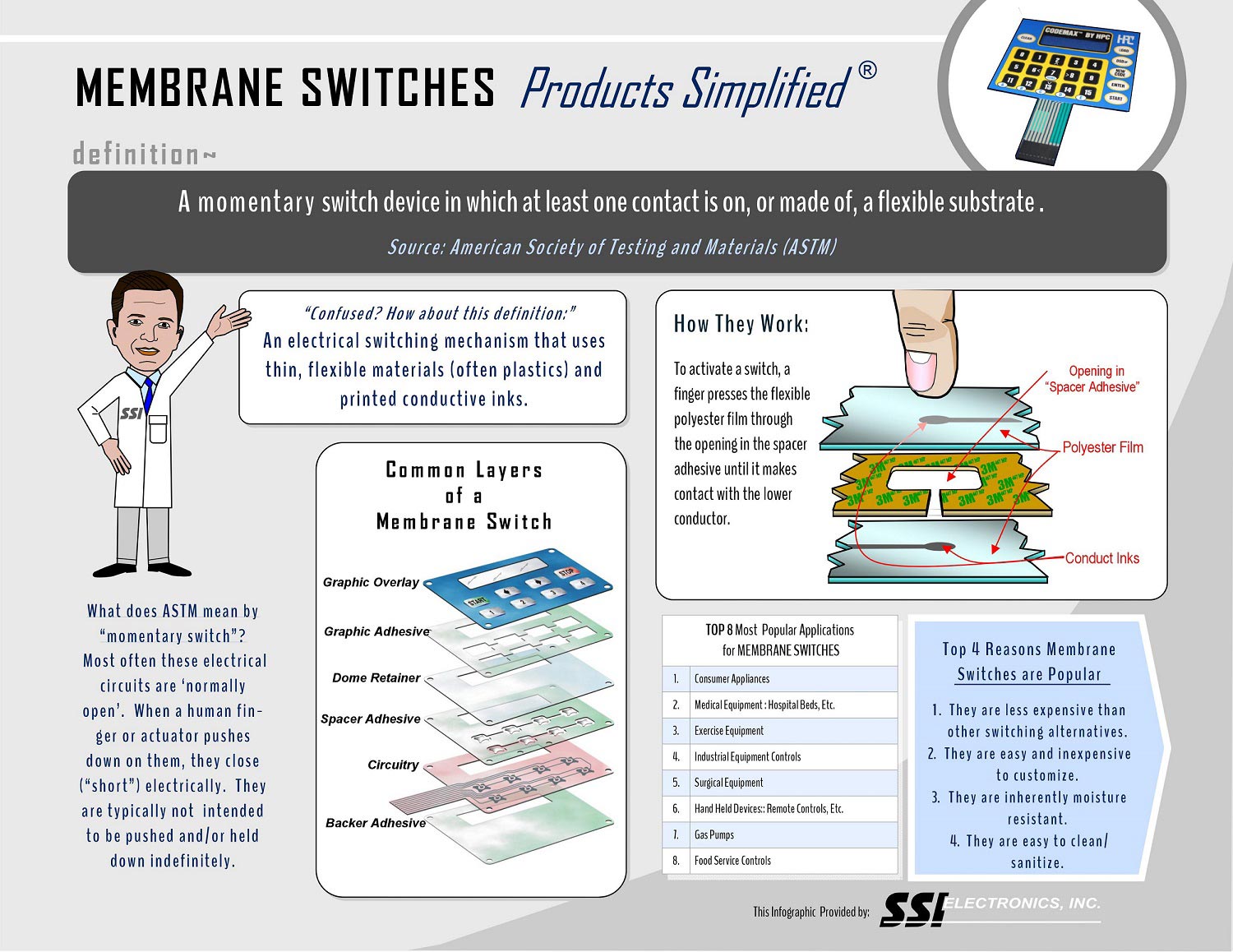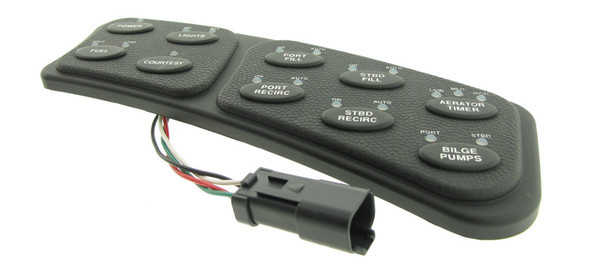5 industries benefiting from membrane switch technology
Everything About Membrane layer Switch Over: A Comprehensive Guide for Beginners
Membrane layer switches are vital parts in modern electronic devices, providing an unique user interface for customer interaction - membrane switch. Their layered building and construction, including overlays and conductive traces, offers capability and longevity. Unlike standard mechanical buttons, membrane buttons present a smooth layout and adjustable choices. Recognizing their vital functions and advantages can transform item design. Nevertheless, the complexities of their application and design factors to consider warrant additional expedition
What Is a Membrane layer Switch?
A membrane button is a kind of electric button that contains a versatile membrane layer layered over a printed circuit board. This design permits a portable and sleek interface, usually utilized in various electronic devices. Membrane layer buttons are generally found in consumer appliances, clinical tools, and industrial machinery due to their durability and resistance to ecological factors.The building and construction generally includes multiple layers, such as visuals overlays and adhesive backing, which provide tactile feedback and protect the circuitry beneath. The procedure of a membrane switch is started when stress is related to the surface area, completing an electric circuit.These buttons are valued for their adaptability, allowing custom-made designs and printed graphics that cater to particular user interfaces. Their low-profile nature decreases space needs, making them ideal for applications where traditional switches may not fit. Overall, membrane layer buttons use a aesthetic and functional option for modern-day digital gadgets.
Trick Components of Membrane Layer Changes
Membrane layer changes consist of numerous essential elements that add to their functionality and efficiency. The top layer, known as the overlay, gives the customer interface and is commonly published with graphics or icons. Below the overlay exists a spacer layer, which separates the conductive aspects and stops inadvertent activation. The following crucial component is the visuals layer, which enhances visual appeals and ensures the toughness of the design.Conductive traces, typically made from materials like silver or carbon, are printed on the circuit layer. When pressure is related to the overlay, these traces come right into call, finishing the circuit. Furthermore, a backing layer uses architectural support and can be made from products such as polyester or polycarbonate. Together, these parts develop a trustworthy, user-friendly user interface suitable for numerous applications, from family appliances to commercial tools. Comprehending these elements is essential for any person thinking about membrane layer switch modern technology.
Exactly How Membrane Layer Switches Work
Recognizing exactly how membrane layer switches over function is necessary for appreciating their widespread usage in numerous devices. A membrane layer switch runs via a series of layers, including a graphic overlay, spacer, and a circuit layer. When stress is put on the overlay, it presses the spacer layer, enabling the circuit layer to make call and complete an electric circuit. This action sends out a signal to the gadget, triggering a reaction, such as switching on a light or triggering a function.Membrane changes can be developed with numerous functions, consisting of responsive responses, backlighting, and custom-made graphics, boosting individual communication. Their building permits a closed style, shielding the interior parts from dust, wetness, and pollutants. This sturdiness makes them ideal for varied applications, from customer electronics to industrial equipment. On the whole, the simpleness and performance of membrane changes add to their popularity in modern-day innovation.
Benefits of Membrane Switches Over Mechanical Switches
While mechanical buttons have actually long been a staple in many devices, membrane switches deal distinctive advantages that make them significantly appealing. One significant benefit is their slim account, permitting more small layouts and better flexibility in item advancement. Furthermore, membrane switches over attribute an uniform surface, which boosts visual allure and streamlines cleaning, making them appropriate for atmospheres where health is critical.Another advantage is their resistance to dirt and dampness. Unlike mechanical buttons, which can be endangered by ecological variables, membrane switches supply a closed interface that safeguards against impurities - membrane switch. Membrane layer switches usually have a longer lifespan due to fewer relocating parts, resulting in improved longevity and reliability.Cost-effectiveness is additionally a noteworthy advantage, as membrane buttons can be produced in bulk with reduced production prices. These factors integrate to place membrane layer switches as a sensible option to typical mechanical options in different applications
Usual Applications of Membrane Layer Switches
Membrane switches are extensively used in different fields, particularly in consumer electronic devices and commercial control panels. In consumer tools, they give a smooth, user-friendly interface, while in industrial settings, they improve resilience and capability. Understanding these applications highlights the adaptability and usefulness of membrane layer switches in modern-day innovation.
Customer Electronic Devices Devices
As consumer electronics remain to evolve, membrane switches have actually become a prominent option for a range of gadgets as a result of their flexibility and smooth style. These switches are typically located in smartphones, tablets, and remote controls, where space is limited and aesthetics matter. Their reduced account and personalized layouts permit producers to develop easy to use user interfaces that boost the total customer experience. Furthermore, membrane buttons are frequently used in appliances such as microwaves and coffee manufacturers, providing intuitive control options while standing up to dampness and dirt. The toughness and integrity of membrane layer changes make Visit This Link them suitable for day-to-day customer items, making sure longevity and regular efficiency. Generally, their combination in consumer electronic devices shows a blend of capability and modern-day style.
Industrial Control Panels
The applications of membrane layer switches over prolong past customer electronics, discovering significant use in commercial control panels. These buttons are preferred for their sturdiness and resistance to extreme environments, making them excellent for making and procedure control settings. They supply a reputable user interface for operators to regulate machinery, display processes, and change setups. Membrane buttons can be customized to fit specific functional requirements, incorporating functions like backlighting and responsive responses, boosting individual experience. Their inconspicuous design enables combination into various equipment, while their capacity to hold up against spills, dirt, and severe temperatures assurances long life. On the whole, membrane layer buttons contribute to reliable and safe procedure in industrial applications, demonstrating their versatility and performance in demanding environments.
Considerations for Creating Membrane Layer Switches
When developing membrane layer switches, choosing the ideal products is vital to ensure resilience and performance. In addition, recognizing layer arrangement strategies can greatly influence the switch's performance and user experience. These considerations play a vital duty in developing trustworthy and effective membrane switch designs.
Product Choice Significance
Material selection plays a vital function in the layout and capability of membrane layer buttons. The selected materials straight impact the button's durability, tactile action, and overall visual. Trick factors to consider include the substratum, which need to provide structural integrity while enabling for versatility, and the visuals overlay, which requires to be immune to wear and environmental elements. Conductive materials should guarantee reputable electrical efficiency, while adhesives need to use strong bonding without compromising the button's operation. In addition, compatibility with making processes and end-user environments is essential; materials have to hold up against varying temperatures, moisture levels, and chemical exposure. Ultimately, ideal click to read material option not only boosts the membrane button's performance yet likewise adds to its durability and user complete satisfaction, making it a crucial aspect of the style procedure.

Layer Configuration Strategies

Often Asked Questions
How Much Time Do Membrane Layer Switches Normally Last?
Membrane switches usually have a life expectancy of 1 to 5 million cycles, depending on use and ecological conditions. Factors such as layout high quality and operating regularity greatly influence their longevity and total performance durability.

Can Membrane Changes Be Personalized for Certain Styles?
Membrane buttons can certainly be customized to suit certain styles, allowing for diverse shapes, colors, and capabilities. This adaptability allows manufacturers to customize these buttons to satisfy one-of-a-kind aesthetic and functional requirements successfully.
What Products Are Used in Membrane Layer Switch Building?
Membrane switches are commonly constructed using products such as polyester, polycarbonate, and adhesive layers. These materials provide adaptability, resistance, and sturdiness to environmental aspects, ensuring the switches operate efficiently in different applications and problems.
Are Membrane Layer Switches Water Resistant or Resistant to Moisture?
Membrane switches can be developed to be moisture-resistant, utilizing specialized coverings and products. Nevertheless, their waterproof capabilities depend upon building high quality and details applications, making it necessary to examine needs for excellent efficiency in numerous settings.
How Are Membrane Changes Fixed if Damaged?
Repairing damaged membrane layer changes normally entails replacing the affected layer or circuit. Specialists may additionally use conductive sticky or utilize specialized repair service kits, making sure capability is brought back without total replacement of the whole button setting up. Unlike conventional mechanical switches, membrane layer buttons present a streamlined style and customizable alternatives. A membrane layer switch is a type of electric button that consists of a versatile membrane layered over a printed circuit board. The operation of a membrane button is started when stress is used to the surface, finishing an electrical circuit.These buttons are valued for their adaptability, enabling customized designs and published graphics that cater to certain user interfaces. While mechanical buttons have long been a staple in several gadgets, membrane layer changes deal unique advantages that make them significantly appealing. Membrane switches commonly have a longer life expectancy due to fewer relocating parts, resulting in you could try here boosted toughness and reliability.Cost-effectiveness is also a significant benefit, as membrane layer buttons can be produced in bulk with reduced manufacturing costs.